
Concept explainers
Neopheliosyne B is a novel acetylenic fatty acid isolated from a New Caledonian marine sponge. (a) Label the most acidic H atom. (b) Which carbon-carbon
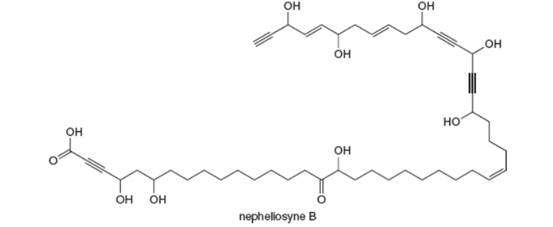
(a)
Interpretation: The most acidic H atom present in nepheliosyne B is to be labeled.
Concept introduction: The most acidic hydrogen
Answer to Problem 11.1P
The labeling of the most acidic H-atom present in nepheliosyne B is shown below.
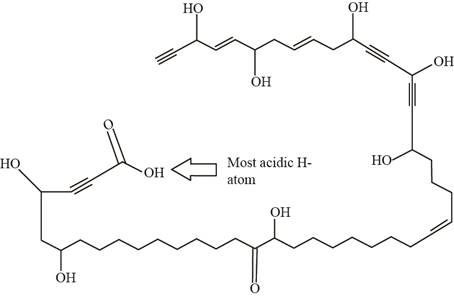
Explanation of Solution
The labeling of most acidic H-atom is shown as,
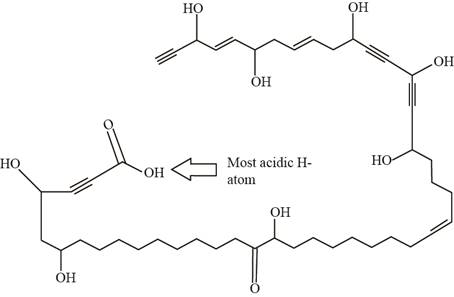
Figure 1
The stability of conjugate base of carboxylic acid is more than the stability of alcohol’s conjugate base. Thus, the acidity of hydrogen atom present in the carboxylic acid is more than that of alcohol because resonance stabilized conjugate base results in an increase in the acidity of a compound.
The labeling of most acidic H-atom present in nepheliosyne B is shown in Figure 1.
(b)
Interpretation: The shortest carbon-carbon
Concept introduction: The higher value of s-character corresponds to the higher electronegativity and lesser bond strength The highly electronegative carbon that is
Answer to Problem 11.1P
The shortest carbon-carbon
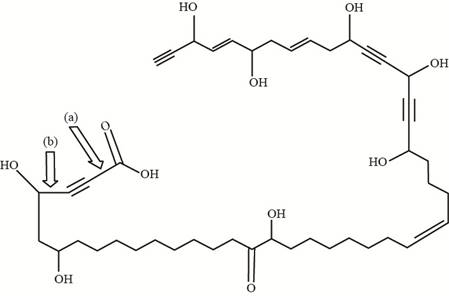
Explanation of Solution
The carbon-carbon
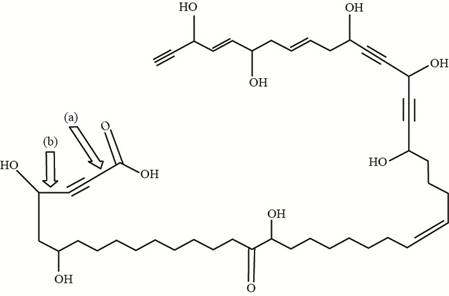
Figure 2
The bond (a) in the given compound is formed by
The shortest carbon-carbon
(c)
Interpretation: The number of degree of unsaturation contained by nepheliosyne B is to be stated.
Concept introduction: The degree of unsaturation states the total number of double bonds, triple bonds or rings present in a compound. It is calculated by the molecular formula of compound containing carbon and hydrogen atom.
Answer to Problem 11.1P
There are total
Explanation of Solution
The molecular formula of nepheliosyne B is given by,
Where
•
Substitute the value of
As the molecular formula of compound contains
The degree of unstauration is calculated by the formula,
Hence, the total number of degree of unstauration present in nepheliosyne B is
The total number of degree of unstauration present in nepheliosyne B is
(d)
Interpretation: The number of bonds formed by
Concept introduction: The procedure of intermixing of the atomic orbitals in an atom is known hybridization. This intermixing of the atomic orbitals is used to form a set of new atomic orbital with different geometry.
Answer to Problem 11.1P
The number of bonds formed by
Explanation of Solution
The number of bonds formed by
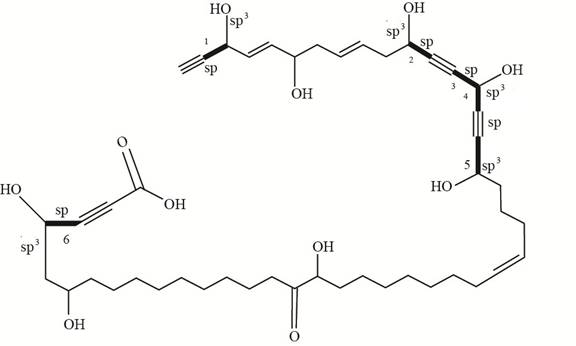
Figure 3
Thus, there are six bonds formed by
The total number of bonds formed by
(e)
Interpretation: Each of the triple bond present in nepheliosyne B is to be labeled as internal or terminal.
Concept introduction: The triple bond or alkyne which contains carbon substituents over acetylenic carbon is known as internal triple bond or alkyne. In case of terminal triple bond or alkyne, there is at least one acetylenic carbon that contains H-atom linked to it.
Answer to Problem 11.1P
The labeling of the triple bonds present in nepheliosyne B as internal or terminal is shown as,
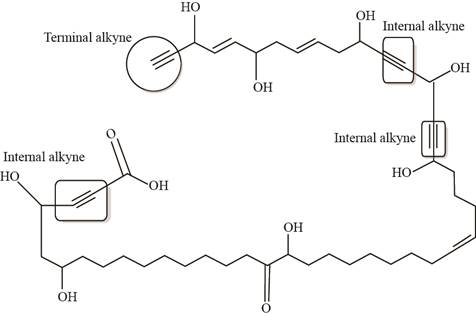
Explanation of Solution
The labeling of the triple bonds present in nepheliosyne B as internal or terminal is shown as,

Figure 4
In Figure 4, there are three internal triple bonds and one terminal triple bond present.
The labeling of the triple bonds present in nepheliosyne B as internal or terminal is shown in Figure 4.
Want to see more full solutions like this?
Chapter 11 Solutions
Organic Chemistry
Additional Science Textbook Solutions
General, Organic, and Biological Chemistry - 4th edition
Campbell Biology: Concepts & Connections (9th Edition)
Campbell Essential Biology (7th Edition)
Brock Biology of Microorganisms (15th Edition)
Human Physiology: An Integrated Approach (8th Edition)
- 12 Mass Spectrometry (d) This unknown contains oxygen, but it does not show any significant infrared absorption peaks above 3000 cm . 59 100- BO 40 Relative Abundance M(102) - 15 20 25 30 35 40 45 50 5 60 65 70 75 80 85 90 95 100 105 mizarrow_forwardDraw a Haworth projection of a common cyclic form of this monosaccharide: H HO H HO H HO H H -OH CH2OH Click and drag to start drawing a structure. Х : Darrow_forward: Draw the structure of valylasparagine, a dipeptide made from valine and asparagine, as it would appear at physiological pH. Click and drag to start drawing a structure. P Darrow_forward
- Draw the Haworth projection of α-L-mannose. You will find helpful information in the ALEKS Data resource. Click and drag to start drawing a structure. : ཊི Х Darrow_forwardDraw the structure of serine at pH 6.8. Click and drag to start drawing a structure. : d كarrow_forwardTake a look at this molecule, and then answer the questions in the table below it. CH2OH H H H OH OH OH CH2OH H H H H OH H H OH H OH Is this a reducing sugar? yes α β ロ→ロ no ☑ yes Does this molecule contain a glycosidic bond? If you said this molecule does contain a glycosidic bond, write the symbol describing it. O no 0+0 If you said this molecule does contain a glycosidic bond, write the common names (including anomer and enantiomer labels) of the molecules that would be released if that bond were hydrolyzed. If there's more than one molecule, separate each name with a comma. ☐arrow_forward
- Answer the questions in the table below about this molecule: H₂N-CH₂ -C—NH–CH–C—NH–CH—COO- CH3 CH CH3 What kind of molecule is this? 0= CH2 C If you said the molecule is a peptide, write a description of it using 3-letter codes separated ☐ by dashes. polysaccharide peptide amino acid phospolipid none of the above Хarrow_forwardDraw a Haworth projection of a common cyclic form of this monosaccharide: CH₂OH C=O HO H H -OH H OH CH₂OH Click and drag to start drawing a structure. : ☐ Х S '☐arrow_forwardNucleophilic Aromatic Substitution 22.30 Predict all possible products formed from the following nucleophilic substitution reactions. (a) (b) 9 1. NaOH 2. HCI, H₂O CI NH₁(!) +NaNH, -33°C 1. NaOH 2. HCl, H₂Oarrow_forward
- Syntheses 22.35 Show how to convert toluene to these compounds. (a) -CH,Br (b) Br- -CH3 22.36 Show how to prepare each compound from 1-phenyl-1-propanone. 1-Phenyl-1-propanone ہتی. Br. (b) Br (racemic) 22.37 Show how to convert ethyl benzene to (a) 2,5-dichlorobenzoic acid and (b) 2,4-dichlorobenzoic acid. 22.38 Show reagents and conditions to bring about the following conversions. (a) 9 NH2 8 CO₂H NH2 CO₂Et (d) NO2 NH2 S NH₂ NO2 CHS CHarrow_forwardive the major organic product(s) of each of the following reactions or sequences of reactions. Show all rant stereochemistry. [10 only] A. B. NaN3 1. LiAlH4, ether Br 2. H₂O CH3 HNO3 H₂/Pt H₂SO ethanol C. 0 0 CH3CC1 NaOH NHCCH AICI H₂O . NH₂ CH3CH2 N CH2CH3 + HCI CH₂CH 3 1. LIAIH, THE 2. H₂Oarrow_forwardCalculate the stoichiometric amount of CaCl2 needed to convert all of the CuSO4 into CuCl2.arrow_forward
 Chemistry: Principles and ReactionsChemistryISBN:9781305079373Author:William L. Masterton, Cecile N. HurleyPublisher:Cengage Learning
Chemistry: Principles and ReactionsChemistryISBN:9781305079373Author:William L. Masterton, Cecile N. HurleyPublisher:Cengage Learning

